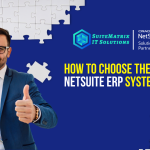Table of Contents
- Introduction
- Why NetSuite is the ERP of Choice in 2025
- Top NetSuite Implementation Challenges
3.1 Poor Project Planning
3.2 Inadequate Data Migration
3.3 Lack of User Training
3.4 Customization Overload
3.5 Integration Issues
- How to Overcome These Challenges
4.1 Start with a Clear Implementation Strategy
4.2 Focus on Clean Data Migration
4.3 Invest in Comprehensive User Training
4.4 Customize with Caution
4.5 Use Proven Integration Tools and Experts
- Final Thoughts
1. Introduction
With a growing number of organizations adopting cloud-based ERP solutions, implementing NetSuite is a significant focus in 2025. Despite offering operational effectiveness, consolidated data, and immediate insights, several businesses encounter hurdles that can postpone or sabotage their ERP objectives. Comprehending the top NetSuite implementation challenges and discovering solutions to address them is vital for sustained triumph.
2. Why NetSuite is the ERP of Choice in 2025
NetSuite’s cloud-first design, modular setup, and capacity to scale continue to make it a leader in the ERP market. Organizations that need scalable ERP solutions and cloud ERP options to support their expansion often choose NetSuite to improve finance, CRM, and operations.
Compared to older ERP platforms, NetSuite offers agility, immediate data insights, and automation – all critical in today’s quick, digital-focused world. The platform is especially attractive to mid-sized businesses that want to prepare for the future and comply with current financial reporting rules.
However, implementing ERP isn’t effortless. Without effective planning and implementation, the advantages of NetSuite can be obscured by complications and uncertainty.
3. Top NetSuite Implementation Challenges
3.1 Poor Project Planning
Starting implementation without a solid plan is a frequent reason for failure. Lots of companies downplay the necessity of careful NetSuite implementation planning, which ends in missed deadlines, exceeding the budget, and objectives not matching up. Very often, the parties involved don’t agree, which allows for increasing project demands and indecisiveness.
3.2 Inadequate Data Migration
Old systems often contain information that’s scattered, obsolete, or duplicated. Bad strategies for moving ERP data lead to reporting errors, difficulties with regulations, and lack of trust in the system. Good data migration is critical for successful implementation. Firms regularly neglect the time and resources necessary to clean, organize, and verify their data, causing lengthy delays.
3.3 Lack of User Training
Effective ERP solutions, like NetSuite, require proper usage. Poor user training in NetSuite leads to reduced confidence, errors, and underused features. Insufficient training also creates workflow problems, leading to user dissatisfaction and reluctance to adapt.
3.4 Customization Overload
Companies sometimes try to duplicate their existing workflows by over-customizing NetSuite. This approach creates technical problems, complicates future updates, and can introduce errors. It also prevents you from taking advantage of future NetSuite advancements.
3.5 Integration Issues
Integrating NetSuite with other applications like CRMs, payroll, or e-commerce tools can become problematic if not planned well. Businesses encounter NetSuite integration problems such as API conflicts, data synchronization problems, and delays in real-time reporting. These challenges can disrupt collaboration and hinder timely decision-making.
4. How to Overcome These Challenges
4.1 Start with a Clear Implementation Strategy
Create a detailed implementation plan with deadlines, costs, and defined responsibilities. Partner with seasoned NetSuite consultants familiar with your sector’s requirements. A solid base reduces errors and keeps everyone on the same page, pursuing the same objective. Before beginning, undertake a thorough analysis of your business processes to pinpoint areas for enhancement.
4.2 Focus on Clean Data Migration
Examine existing data, remove redundancies, and set up data validation checks. Employ NetSuite’s data migration tools, involving your IT and financial staff from the start. Confirm the imported data matches your business rules. Develop a comprehensive testing plan to detect any data issues before going live.
4.3 Invest in Comprehensive User Training
Create role-specific training materials, including guides, live training sessions, and ongoing support after launch. Furnish your staff with NetSuite training resources to encourage adoption and minimize pushback. Employ built-in guidance tools and choose internal champions to assist your team during the switch.
4.4 Customize with Caution
Follow NetSuite best practices and employ configurations before customizations. Concentrate on scalable adjustments that support your long-term ERP goals. Rely on your NetSuite customization specialists to strike the right balance. Steer clear of isolated scripts that might cause problems with future system updates.
4.5 Use Proven Integration Tools and Experts
Prevent integration complications by collaborating with specialists and leveraging certified NetSuite integration platforms. This ensures immediate data transfer between NetSuite and other crucial systems. Pick middleware that offers effective error handling and scalable architecture.
5. Final Thoughts
In 2025, a triumphant ERP launch is not solely about installing software. It encompasses meticulous planning, thorough training, and refining each stage of the process. By proactively tackling these NetSuite implementation obstacles with the appropriate strategy, resources, and aid, your company can achieve genuine digital transformation.
SuiteMatrix is prepared to help you handle ERP’s intricacies with skill and attention. Our services are structured to assist enterprises in lessening implementation risks, boosting NetSuite ROI, and streamlining business operations via smart ERP solutions.
Let’s fortify your business for the future and develop a more intelligent ERP environment, in partnership.



